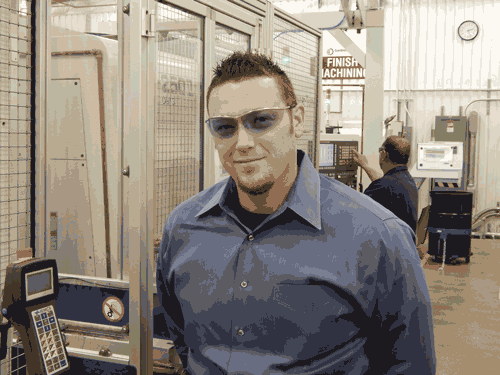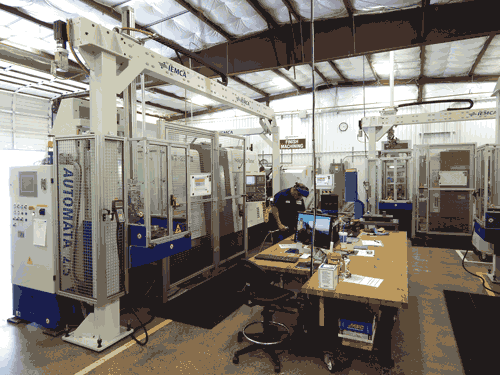Win-Win Scenario Automates a High Volume Turning Operation
What started as a sales call from Bucci Industries to Methods Machine Tools evolved into a true success story at Gardner Denver's Fort Worth, Texas facility.
In the fall of 2011, Paolo Raspanti, executive V.P., and Cory Miller, V.P. of operations at Bucci Industries, visited Methods Machine Tools, importer of Nakamura Tome Turning Centers and other machine tool lines in the U.S. There, they met with John Lucier, automation manager, and Rich Parenteau, director of application development.
Bucci Industries was well known to Methods as the manufacturer of IEMCA automated bar feeders. Mr. Raspanti and Mr. Miller had worked with Methods on projects in the past and wanted to update the company on Bucci’s new products and product upgrades.
The meeting was well timed as Mr. Parenteau discussed that one of their clients, Gardner Denver, was interested in installing a new turning operation to manufacture pump parts used in the energy industry. The focus of the meeting changed when Bucci’s Automata gantry loader was introduced.
The customer’s goal was to have a highly automated operation with multiple Nakamura lathes and minimal personnel. To accomplish this goal, an automated loader would have to be connected to the lathes. Mr. Parenteau was looking for the right automation solution for this large project, with a relatively short time line for installation. “The more we discussed the project, the more apparent it became that our Automata 5.0 gantry loader was a good solution,” Bucci’s Mr. Miller says.
Opportunity Knocking
The delivery and the budget for the project provided an opportunity for the gantry loader. The IEMCA Automata is a generic gantry system designed and built for automatic loading, unloading and storing blanks and finished components close to the machine tool.
The gantry units could be manufactured in time to meet the projected deadline, and their cost was significantly less than a six-axis robot option, which was being considered. Additionally, the gantry loader was ideal for moving the parts, some of which weighed up to 11 lbs. “From a price and delivery perspective, the Automata made a lot of sense for this project,” Methods’ Mr. Parenteau says.
Mr. Miller says, “We had been looking for an opportunity to present our Automata to Methods Machine Tools. It was interesting that this desire and the timing for this project coincided perfectly.”
The information sharing and proposal processes began. Within weeks, the engineering and manufacture of the system components began.
Fresh Start
Gardner Denver was in the process of renovating an existing wing at their Ft. Worth manufacturing facility to house its Nakamura Tome WT250 lathes connected to Automata 5.0 gantry loaders. The automated facility was expected to produce in excess of 100,000 parts per year with an operations staff of two people per shift. It was a lofty goal, but one made viable by the lathe and gantry loader selection.
The production and installation process took place in three phases for more than 4 months in the spring and summer of 2012. The first loader was manufactured at Bucci’s plant in Italy and shipped to the Methods’ Massachusetts location to be married to the lathe and programmed for the variety of parts that would be manufactured. The Nakamura lathe and Automata 5.0 proved to be a good combination as both were capable of the quick change-overs that would be required to manufacture a variety of parts.
“The 2-week runoff went well and allowed us to adapt both machines to meet the project requirements,” says Ed Joseph, Bucci’s Automation Specialist. The process included the gantry loader taking raw material from the magazine and loading them into the main spindle of the lathe. Then the loader removes the finished part from the lathe and places it back in the staging area. The entire process takes 5 to 10 minutes to produce the finished product.
“The variety of parts to be manufactured required us to make several adjustments at the runoff to ensure a smooth manufacturing process with an easy change-over. There were also some parts that were not available at the runoff for testing. These would have to be programmed at the factory installation,” Mr. Joseph added.
The next phase of the project involved moving the first lathe and gantry loader unit to the newly renovated building at Gardner Denver’s Ft. Worth facility. While this unit was being installed, the additional lathes and gantry loaders were being manufactured and prepared for their respective runoffs. The installation of all the additional units would be completed over a 4-month period.
Getting More Efficient
Gardner Denver supplies pumps to a variety of industries worldwide. The products that would be manufactured in Ft. Worth were being utilized in a high growth industry that the company wanted to expand into.
These were high turnover parts, and high production levels were necessary. Additionally, production speed was extremely important. The option of having each lathe manned by a skilled operator, as well as an assistant, would not have met the company’s production or financial goals.
Larry Kerr, V.P. and general manager of Gardner Denver decided early in the planning stage that this new production process would require automation to be successful. He built this into the specifications for the project.
“Our company operates on a lean manufacturing philosophy, coupled with a Six Sigma customer focus,” says Mike Young, plant manager at Gardner Denver. “This was our division’s first entry into high volume manufacturing. We knew up front that it would require an automated component to accomplish our goals.”
Mr. Joseph handled the installation of the gantry loaders for Bucci. Coordinating with Gardner Denver personnel and the Methods lathe installers, he was able to bring the Automata online within 2 weeks. Some adjustments at the plant level were necessary to accommodate access to the lathe and the gantry.
“The first week we were installing the Automata and setting up the programming. On week 2, we ran testing and trained the lathe operators and maintenance personnel,” Mr. Joseph says. “Overall, the installation went well. Naturally, on any project as complex as this one, we had adjustments to make to meet the end user’s needs. “
Lessons Learned
Once the first combined unit was installed and producing product, the focus shifted to the installation of the next units. With lessons learned from the first system, changes were made to the lathe and the gantry loader units.
The additional units were installed over a 3-month period. As all of the systems were brought online and part production began, additional changes were made as new parts were added to the production cycle mix.
For example, Gardner Denver operators standardized their tray system for the gantry loader. Additional programming was incorporated and many of the system’s components were altered to handle the various parts being manufactured with accuracy.
“There is always a learning curve when you make the decision to automate,” says Mr. Young of Gardner Denver. “The key is to partner with vendors who will help you through the process. The people from Methods and Bucci were there with us every step of the way. I’ve seen Cory Miller, Bucci’s V.P., on a ladder turning wrenches.”
It’s Working
As the systems consistently run two shifts, the many advantages this automated approach to manufacturing offers became apparent to Gardner Denver. Most important, the units were exceeding the production expectations, manufacturing more than 10,000 parts a month.
Additionally, all the units were being run with only two people per shift. “If we had not automated this process, we would have had to have two machinists assigned to each lathe to load, unload and check the parts,” Mr. Young says. “That adds up to six people versus four people when you are running two shifts. And if someone calls in sick, you have equipment that is not running.
“This equipment allows us to concentrate on the process, not the people,” he adds. “We do need a higher level of machinist for this equipment—we just don’t need as many of them.” The machinists that run the lathes and gantry loaders must have knowledge of G code programming. Several of the company’s operators have been trained in this skill set. It will be a skill sought after in new employees.
“One of the reasons companies are so interested in automation is that this equipment, once it is running, is going to have 90 percent uptime,” says Methods’ Mr. Parenteau. “When the equipment is run by an operator, you are probably looking at 60 to 70 percent uptime. Automation pays for itself.”
Increased product consistency is another advantage Gardner Denver has realized. “Our first pass yield has definitely improved,” Mr. Young says. “People are a variable. This equipment is not. Everything is repeatable and consistent.”
“That is the really big advantage of the programmable material handling automation,” Mr. Joseph says. “Once it is programmed, it will consistently pick up and move parts without variation. This guarantees that the parts will be placed in the lathe the same way each time.”
Another advantage with using automated equipment is that management has more control over the time the process takes. If a few seconds can be shaved off the time it takes to make the product, this can translate into higher productivity. “In a highly repeatable process like this, we’ve seen opportunities to increase our throughput,” Mr. Young says.
For Gardner Denver, this venture into automated production has paid off for several reasons. They had a clearly defined vision of their objectives, a willingness to invest in automation technology and vendor partners committed to the success of their project.
Down the Road
Gardner Denver’s new equipment has allowed the company to aggressively capture opportunities in a new market. This investment is profitable and is seeing growth for the company.
In addition, it is providing new opportunities to manufacture parts in other market sectors and expand their product offering. Because the equipment is so adaptable, this can be done at a minimal additional cost.
“Automation is definitely the trend in manufacturing today,” Mr. Young says. “The Automata combined with the Nakamura lathe has definitely met our needs and is allowing for expansion. That is a good return on investment for Garner Denver.”
Related Content
High-Volume Machine Shop Automates Secondary Ops
An Ohio contract shop added a compact, self-loading CNC lathe to perform unattended secondary ops on a part for a key customer rather than running it on a manually loaded chucker.
Read More4 Bright Ideas for Effective Lights-Out Machining
Adopting lights-out machining involves considerations when a machine shop decides to move forward with the process. Here are some tips to a successful implementation.
Read MoreTips for Troubleshooting and Repairing Chip Conveyors
A nonfunctioning chip conveyor can cause a high-production machine to be down for an extended period of time. Here is some troubleshooting advice if you’re having issues with your chip conveyors.
Read MoreReinventing the Wheel with Robot-Automated CNC Multitasking
One race team discovers how to efficiently manufacture a new wheel nut design for the next-generation NASCAR stock car with the help of a CNC mill/turn and a built-in robot.
Read MoreRead Next
Gantry Takes Hands Out Of Part Handling
Automating material delivery and removal from the machining process is one key method of taking some of the production cost from manufacturing. Iemca, known for automating machine tools with its line of bar feeders, has introduced a new gantry system for chucked parts.
Read MoreA Tooling Workshop Worth a Visit
Marubeni Citizen-Cincom’s tooling and accessory workshop offers a chance to learn more about ancillary devices that can boost machining efficiency and capability.
Read MoreDo You Have Single Points of Failure?
Plans need to be in place before a catastrophic event occurs.
Read More

























